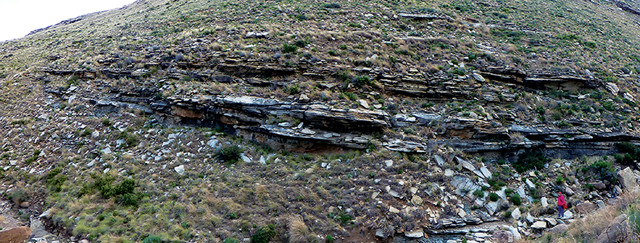
by Lucas Joel Thursday, December 31, 2015

Sandstones and volcanic deposits at Old Lootsberg Pass in South Africa's Eastern Cape Province preserve fossil and geochronometric evidence suggesting that the Permian-Triassic terrestrial and marine extinctions were not simultaneous. Credit: Robert A. Gastaldo.
Life on land and in the sea was nearly eradicated about 252 million years ago in the largest-known mass extinction. The cataclysm, known as the Permian-Triassic (P-T) mass extinction, was likely driven by extensive flood basalt volcanism in Siberia and is thought to have affected global biodiversity simultaneously. However, based on analyses of rocks deposited around the time of the P-T boundary in the Karoo Basin of South Africa, scientists suggest in a new study that the terrestrial turnover in vertebrates occurred earlier than the marine extinction. If true, a second trigger — other than Siberian volcanism — might need to have occurred to explain both events.
Terrestrial rocks on both sides of the P-T boundary show a turnover in vertebrate ecosystems, says Robert Gastaldo of Colby College in Maine, lead author of the new study in Geology. In particular, fossils of Dicynodon — a genus of small, herbivorous therapsids — disappear from the Karoo Basin, while other taxa, namely Lystrosaurus, a different type of herbivorous therapsid, become pervasive. This turnover is thought to have been caused by volcanism-induced climate change that drove massive die-offs of plants like Glossopteris and, in turn, sparked the extinction of many Permian herbivores, including Dicynodon, which could not adapt to the new vegetative landscape.
However, Gastaldo says, “from our fieldwork in the Karoo, we’ve found discrepancies in this traditional model of the terrestrial response to the extinction.” Along with collecting paleomagnetic measurements from a stratigraphic section previously reported to surround the P-T boundary in the basin, he and his team discovered volcanic ash deposits in the same part of the section where the vertebrate turnover is observed. Using radiometric dating, the team dated the ash layer to about 253.5 million years old. “This means the turnover was in the early Changhsingian [Age],” Gastaldo says, and thus not even close to the time when the marine ecosystem was destroyed at roughly 252 million years ago.
Further evidence also indicates that the terrestrial P-T extinction occurred before the marine extinctions. In China, just below where the marine extinction event is seen in the stratigraphic record, paleomagnetic data from previous studies have indicated that the planet’s magnetic field flip-flopped from a reverse orientation, meaning magnetic north and south were opposite from how they’re oriented today, to a normal orientation. And earlier studies of the Karoo have shown a magnetostratigraphy that’s similar to what is seen in China, Gastaldo says. “But our paleomagnetic data differ considerably because the [transition] zone that’s supposed to be just below the extinction event is now about 55 meters below the last appearance of Dicynodon.”
This, along with the team’s new date for the vertebrate turnover, implies that an extinction on land predated the marine extinction. Gastaldo says the results of previous magnetostratigraphic work in the basin might differ from what his team found due to sampling differences: For each of about 90 stratigraphic horizons he and his colleagues examined, they retrieved roughly 10 samples, he says, providing paleomagnetic data at a higher resolution compared to previous efforts that typically only retrieved one core per horizon from widely spaced beds.
But measuring paleomagnetism in the Karoo is complicated, says Spencer Lucas, a paleontologist at the New Mexico Museum of Natural History and Science who was not involved in the work. “It was long believed that you couldn’t get reliable magnetic data from these rocks, because the magnetic signatures from when the rocks initially formed had been reset” by volcanism, he says. This is cause for skepticism over the team’s magnetic data, Lucas says, adding, however, that he otherwise agrees with the interpretations presented in the study.
Lucas notes that accurate dating is essential because “this study goes after the most important question about the land extinction: Did it occur exactly when the extinction occurred in the sea?” If the two were simultaneous, “then you could argue that there was one cause for both extinctions,” he says. “If their findings are correct, though, then they must have had different causes.”
Part of the difficulty in studying the boundary, says Sylvie Bourquin, a sedimentologist at the University of Rennes in France who was not involved in the work, is that “precise, absolute time constraints in continental paleoenvironments [from the period] are difficult to establish due to a general [scarcity] of dateable rock.” Additionally, there has been little study of the interactions between marine and terrestrial environments that existed at the time, she says. “Researchers tend to work on either marine or on terrestrial rocks, so it is very hard to understand the real response to the crisis at a global scale.”
Because the types of environments can contain subtle differences, Bourquin says, studying P-T boundary sedimentary basins where marine and terrestrial environments were interconnected should help to further refine the relative timing of the land and sea extinctions.
© 2008-2021. All rights reserved. Any copying, redistribution or retransmission of any of the contents of this service without the expressed written permission of the American Geosciences Institute is expressly prohibited. Click here for all copyright requests.